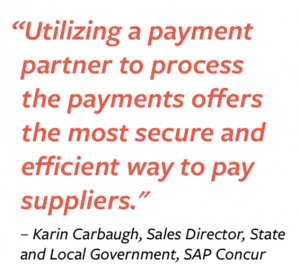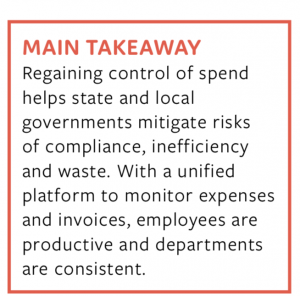This article is an excerpt from GovLoop’s recent guide, “Intelligent Innovation: Tech Trends Taking Root in State and Local Governments.” Download the full guide here.
State and local governments throughout the country face their own unique challenges. But a common difficulty for all is tracking where tax dollars are spent.
Accounts payable departments have to field a variety of expenditures, whether that’s expensing an employee’s taxi ride or approving a million-dollar contract for a vendor. To be a steward of taxpayers’ dollars, however, governments need to ensure that all spending is efficient, transparent and compliant.
Until now, doing so was painstaking and, in cases, could be impossible. With modern solutions, however, state and local governments can achieve holistic and easy-to-access insights into their spending. To learn how state and local governments can reclaim control of their finances, GovLoop spoke with Sherri Schuller, State and Local & K-12 Regional Sales Executive, and Karin Carbaugh, Sales Director, State and Local Government, at SAP Concur. SAP Concur helps governments manage expenses, indirect expenditures and vendor invoices in one central platform.
Tracking expenditures manually is time-consuming, wasteful and often siloed. Worse, it opens agencies up to issues of fraud and abuse when expenditures can’t be monitored before they’re processed. Schuller said that recently, a state employee went outside of their role to log invoices that paid a family member’s account, an auditor found.
“If you don’t have the checks and balances to ensure the bills are compliant or pre-approved, this type of fraud can easily go unchecked,” Schuller said.
These problems arise because of decentralization in state and local governments, where spending might be carried out by individuals within different departments throughout the state. To rectify the situation, departments need oversight and insight of spending in real time, which can only be accomplished through up-to-date solutions.
Solutions such as those offered by SAP Concur allow departments to incorporate and automate policies in accounts payable under one umbrella, preventing misuse on the front end for both expenses and invoices. Furthermore, the solution relies on role-based actions within the system and gives supervisors the ability to compare expenditures to historical data.
“Utilizing a payment partner to process the payments offers the most secure and efficient way to pay suppliers,” said Carbaugh. “The added benefit of working with a payment partner is that the organization is often able to receive a steady flow of rebates that, many times, can become a revenue stream.”
 Finally, end users are also the beneficiaries, as they can file expenses and process invoices remotely and easily. If employees, for example, can integrate their ride-sharing apps with expense reporting, they can spend less time filing tedious reports.
Finally, end users are also the beneficiaries, as they can file expenses and process invoices remotely and easily. If employees, for example, can integrate their ride-sharing apps with expense reporting, they can spend less time filing tedious reports.
“It’s not only creating efficiencies and driving costs out of processing these large buckets of spend, but it’s also creating employee productivity,” Schuller said.
By monitoring and controlling spend, state and local governments can bridge the gap of decentralization, allowing employees to work on the road and departments to operate independently – all under the shield of one streamlined, compliant and transparent government.






Leave a Reply
You must be logged in to post a comment.